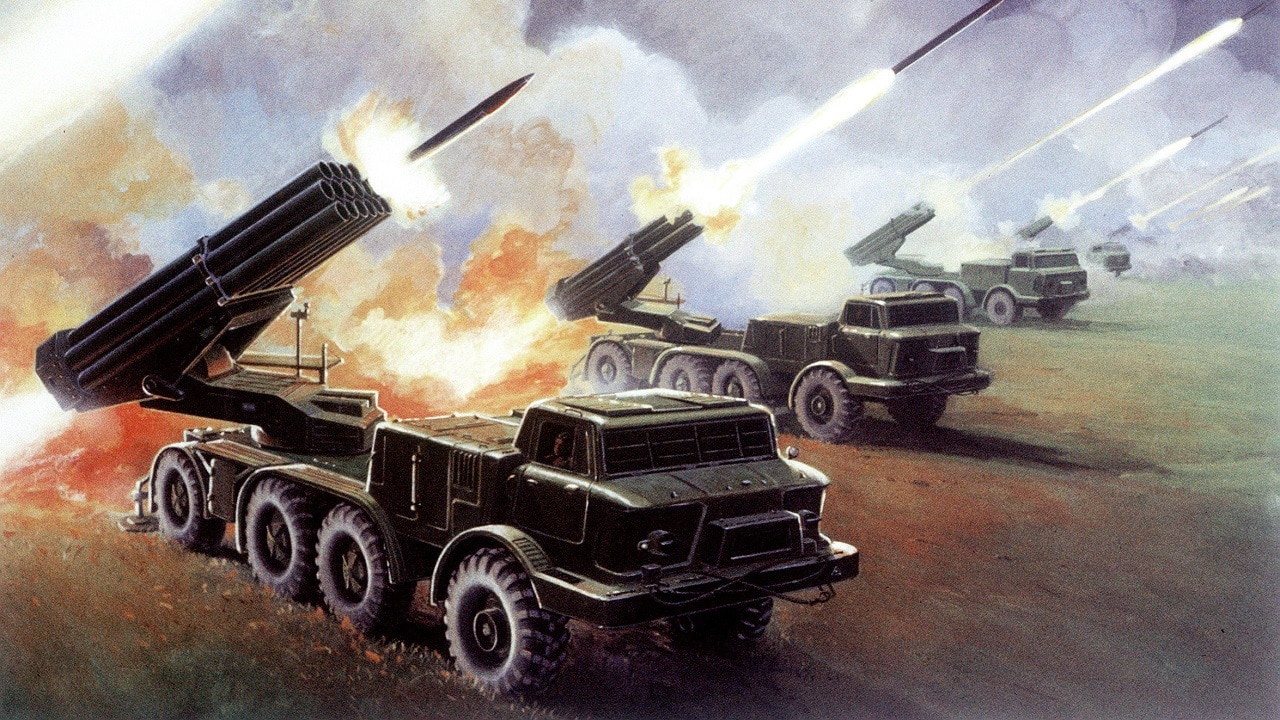Russia has started operationally deploying in the Special Military Operation (SMO) zone a deeply modernized variant of its legacy Urugan multiple rocket launcher system (MLRS), with features similar to, perhaps better than, the US-supplied HIMARS system.
According to Kotsnews TC, which reported the deployment, the modernized 9K57-1M Uragan-1M was first revealed during the Army 2020 military-technical forum.
Like the US HIMARS, the Uragan-1M is a dual-calibre system – it’s fitted with two different launch containers to launch either 220-mm rockets of the legacy Uragan MLRS or 300-mm rockets developed for the Smerch (Tornado-S) MLRS. The latter have SATNAV guidance and a max range of 120 km.
Legacy BM-27 Uragan
The legacy BM-27 Uragan MLRS is a self-propelled 220 mm MLRS inducted into service with the Soviet Army in the late 1970s. It was the first Soviet MLRS to feature a spin and fin-stabilized heavy multiple rocket launcher.
The system features 16 launch tubes mounted on the rear of a ZIL-135 8×8 chassis with a maximum cruising range of 500 kilometers. The rockets weighing 280.4 kg feature HE or cluster warheads weighing 90 to 100 kilograms and have a range of 35 km.
Legacy BM-30 Smerch
The legacy Smerch MLRS was inducted into the Soviet Army in 1987. The MLRS has 12 tubes for 300-mm rockets; each 7.6-meter-long standard missile weighs about 800 kilograms. It has a firing range of between 20 and 70 km.
In January 2017, according to a Sputnik report, there were 200 220mm Smerch and over a hundred 300mm Uragan long-range rocket launchers currently in service with the Russian Armed Forces.
According to reports, India has a total of 372 Smerch launchers in service. The launchers are mounted on an Indian-made T816 KOLOS TATRA.
Smerch (Tornado-S)
The Smerch Tornado-S system features SATNAV-guided rockets and an automated digital Fire Control System.
According to Rostec, the precision-strike rockets have an effective range of over 100 km, and the fire accuracy of Tornado-S projectiles is 15-20 times higher than that of the munitions used by the Smerch predecessor.
Though Tornado-S MLRS has range capabilities similar to the US HIMARS system, its operational agility is limited by its tube-based rocket launch system, wherein each tube has to be reloaded individually with a specialized vehicle. The HIMARS system features a replaceable pod with 6 launch tubes. The system can be simply reloaded by fitting a new pod.
The HIMARS carries one pod with either six Guided Multiple Launch Rocket System (GMLRS) rockets or one Army Tactical Missile System (ATACMS) missile. Both the pods look similar, making it difficult to distinguish a GMLRS system from an ATACMS system.
9K57-1M Uragan-1M
The 9K57-1M is a deep modernization of the Soviet Uragan MLRS. Like the HIMARS, it’s dual-calibre in nature. The installation can fire both “native” Uragan 220-mm rockets in various configurations as well as 300-mm ammunition of the Smerch (Tornado-S) MLRS.
Like the HIMARS, the Uragan-1M can be reloaded simply by replacing the containers, which increases mobility and reduces turnaround time.
The 9K512 Uragan-1M is equipped with a pair of pods, each containing either 15 units of 220 mm caliber rockets, or 6 300 mm caliber rockets, for a total of 30 or 12 different types of ammunition. It is possible for the Uragan to mix the ammunition – carry one pod with 15 220 mm rockets and one with 6 300 mm rockets.
The pods can be changed in just 4 minutes.
The use of two pods makes the Uragan-1M more versatile than the single-pod HIMARS launcher.
The Uragan-1M, manned by a crew of three, weighs 31.2 tons without any pods and over 42 tons with a pod. It’s capable of doing 70 kph on a highway and can switch from cruise to combat in 20 seconds. The cruise range is 1000 km.

All processes in Uragan-1M are fully automated. The electronic equipment installed on the system facilitates networking with reconnaissance assets and other strike complexes, making it possible to carry out strikes in real time with high efficiency.
Conclusion
Conceptually, the Uragan-1M is a more advanced MLRS system than even the HIMARS. The system carries more rockets and has the ability to carry rockets of different calibers simultaneously.
Currently, only the 300 mm rockets of the system are known to be guided. In the future, the 220 mm rockets could also feature SATNAV guidance.
The Uragan-1M likely weighs significantly more than the HIMARS, constraining its air mobility. As far as the SMO is concerned, the shortcoming is unlikely to be of concern to Russian commanders.
Operational deployment of the system will certainly impact the course of the SMO if serial production is already underway. Keeping in mind Russia’s demonstrated ability to ramp up production, with the passage of time, the impact of the system on the course of operations will be significant.
The Uragan-1M MLRS appears to be yet another new Russian weapon system set to turn the tide decisively against Ukraine.
- Vijainder K Thakur is a retired IAF Jaguar pilot. He is also an author, software architect, entrepreneur, and military analyst. VIEWS PERSONAL
- Follow the author @vkthakur